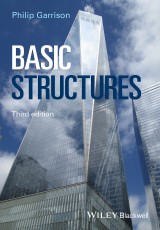Details

Basic Structures
3. Aufl.
|
39,99 € |
|
| Verlag: | Wiley-Blackwell |
| Format: | |
| Veröffentl.: | 03.02.2016 |
| ISBN/EAN: | 9781118950869 |
| Sprache: | englisch |
| Anzahl Seiten: | 432 |
DRM-geschütztes eBook, Sie benötigen z.B. Adobe Digital Editions und eine Adobe ID zum Lesen.
Beschreibungen
<i>Basic Structures</i> provides the student with a clear explanation of structural concepts, using many analogies and examples. Real examples and case studies show the concepts in use, and the book is well illustrated with full colour photographs and many line illustrations, giving the student a thorough grounding in the fundamentals and a 'feel' for the way buildings behave structurally. With many worked examples and tutorial questions, the book serves as an ideal introduction to the subject.
<p>Acknowledgements ix</p> <p>Introduction x</p> <p>1 What is structural engineering? 1</p> <p>2 Learn the language: a simple explanation of terms used by structural engineers 8</p> <p>3 How do structures (and parts of structures) behave? 11</p> <p>4 Force, mass and weight 26</p> <p>5 Loading – dead or alive 32</p> <p>6 Equilibrium – a balanced approach 38</p> <p>7 More about forces: resultants and components 43</p> <p>8 Moments 54</p> <p>9 Reactions 67</p> <p>10 Different types of support – and what’s a pin? 73</p> <p>11 A few words about stability 81</p> <p>12 Introduction to the analysis of pin-jointed frames 93</p> <p>13 Method of resolution at joints 98</p> <p>14 Method of sections 119</p> <p>15 Graphical method 127</p> <p>16 Shear force and bending moments 137</p> <p>17 This thing called stress 168</p> <p>18 Direct (and shear) stress 173</p> <p>19 Bending stress 184</p> <p>20 Combined bending and axial stress 205</p> <p>21 Structural materials: concrete, steel, timber and masonry 218</p> <p>22 More on materials 229</p> <p>23 How far can I span? 235</p> <p>24 Calculating those loads 242</p> <p>25 An introduction to structural design 252</p> <p>26 More on structural types and forms 291</p> <p>27 An introduction to deflection 310</p> <p>28 Shear stress 324</p> <p>29 Buckling and torsion 333</p> <p>30 Frames and three-pinned arches 344</p> <p>31 Virtual work 356</p> <p>32 Squares and circles of stress: An introduction to Mohr’s Circle 363</p> <p>33 Trusses (no numbers) 380</p> <p>34 Plastic analysis 388</p> <p>Further reading 402</p> <p>Appendix 1: Weights of common building materials 403</p> <p>Appendix 2: Conversions and relationships between units 405</p> <p>Appendix 3: Mathematics associated with right-angled triangles 407</p> <p>Appendix 4: Symbols 409</p> <p>Appendix 5: A checklist for architects 410</p> <p>Appendix 6: Getting more out of civil engineering 411</p> <p>Index 413</p>
<p><b>Philip Garrison</b> BSc MBA CEng MICE MIStructE MIHT is a Chartered Civil and Structural Engineer and Senior Lecturer in Structural Design in the Civil Engineering Departmentat Leeds Beckett University</p>
<p>Structural engineering is a key part of the design of the entire built environment. How a structure, for example a building or bridge, behaves when subjected to various forces – the weight of the materials that were used to build it, the weight of the occupants in it or the traffic it carries, the force of the wind etc – is fundamental to its success. Students of construction, architecture and civil engineering have to be confident in their understanding of structures, but many find the basic concepts difficult to understand and apply. <br /><br /><i>Basic Structures</i> was written to:</p> <ul> <li>explain structural concepts using analogies and examples to illustrate the key points</li> <li>express the mathematical aspects of the subject as clearly as possible and in context with the concepts involved</li> <li>maintain reader interest by using real-life examples and case histories to underline the relevance of the material</li> </ul> <p>As such it provides the student with a clear explanation of structural concepts using many analogies, diagrams, clear examples and exercises. These concepts are illustrated in a range of case studies and the book contains many full colour photographs and line illustrations. This new edition sees the addition of 7 new chapters which together serve as an easy introduction to some more advanced topics in structural engineering and design.</p> <p>Like the preceding two editions, this third edition continues to give students of civil engineering, architecture and related disciplines such as quantity surveying, building surveying, construction management and architectural technology, a thorough grounding in the fundamentals and a 'feel' for the way buildings behave structurally.</p>
Diese Produkte könnten Sie auch interessieren:

Composite Structures according to Eurocode 4
von: Darko Dujmovic, Boris Androic, Ivan Lukacevic
Preis: 97,99 €
-
-
© 2024 media control GmbH
Alle Preise enthalten die gesetzliche Mehrwertsteuer. - AGB
- Impressum
- Datenschutzerklärung
- Kontakt
- FAQ
- Mein Konto
- Home
- Erweiterte Suche
- Widerrufsrecht
- Reader-Software
- Desktop-Ansicht
- Gutschein-Code einlösen
- English

